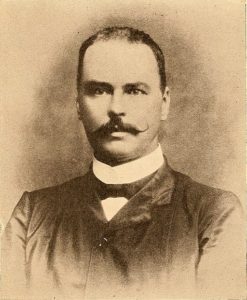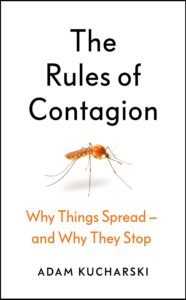Throughout eight ingenious chapters, the author provides valid and pertinent answers about the rules involved in infectious processes. In his exploration, he employs mathematical and statistical models to unravel the cycle of epidemic spread and estimate the consequences of social behavior.
It should be noted that the text does not focus exclusively on infectious diseases. Kucharski amply demonstrates that outbreaks can occur in different spheres of daily life. In this way, the research transcends the field of biology and explores the contagious processes that can occur in social, economic and technological activities. The mathematician explains that the principles of epidemiology can be applied to analyze all kinds of things such as ideas and innovations, fake news, financial bubbles, viral content, memes, fairy tales, yawns, and even violent crime.

The Rules of Contagion: Why Things Spread and Why They Stop begins by describing Dr. Ronald Ross’s revealing and decisive research on malaria, one of the oldest and most lethal infections that has ever plagued mankind. Dr. Ross became renowned because he defined the role of the anopheles mosquito as the transmitting agent of malaria. As a result of this discovery, he was awarded the second Nobel Prize in Medicine in history (1902).
The SIR model: Why does an outbreak scale? How many people does it infect?
Adam Kucharski uses the SIR epidemiological model to describe the basic rules of contagion. Infectious disease specialists use mathematical models to understand the mechanisms that influence the spread of pathogens, predict their course, and guide the control efforts of health agencies.
The author says that in 1927, biochemist William Kermack and Dr. Anderson McKendrick proposed what is now widely known as the SIR model. These researchers expanded the precursor ideas of Dr. Ronald Ross and the audacious mathematician Hilda Hudson. It is worth mentioning that, this model holds a prominent place in epidemiology because it revolutionized the way of seeing contagion.
Basically, Kermack and McKendrick devised an exclusionary compartment model. In this sense, the SIR model divides the total population into three epidemiological groups: 1) the susceptible, 2) the infected, and 3) the recovered. The objective of this tool is to analyze the flow between the different compartments.
1) Susceptible Population (S). This represents the number of healthy people who are at risk of contracting the infection. When a susceptible person becomes infected with the pathogen, he/she becomes part of the infected group.
2) Infected Population (I). This represents the number of sick subjects who can transmit the infection. At some point, the infected will belong to the recovered class.
3) Recovered Population (R). This represents the number of individuals who overcome the disease. Retired persons (isolated in quarantine) and those who die also enter this compartment.
Although more recent mathematical models have included more complex aspects, the SIR model has proven to be robust and rigorous enough to prevail over time.
Now, what is the average number of contagions from a single infected patient?
In this respect, the mathematical model proposes a threshold quantity designated as the: “basic reproduction number” or “R0”. Scientists use R0 to determine the intensity of an outbreak.
In other words, R0 represents the average number of infections that would occur if an infected person is introduced into a susceptible community. If R0 is less than 1, there will be no outbreak. On the contrary, if R0 is greater than 1, then the disease will grow with potential.
Among the “reproduction numbers” of general interest, we have: Ebola/ R0 = 2 average cases, Varicella/ R0 = 6 – 8 (in a population of susceptible), COVID-19/ R0 = 2 – 3 (without sanitary measures).

How do ideas spread?
The professor of epidemiology explains that disease outbreaks and information outbreaks tend to follow familiar patterns.
This idea originated around 1960 with the work of mathematician William Goffman, who wanted to study the propagation pattern of scientific articles. His intention was to apply epidemiological models to the field of ideas. He soon realized that scientific publications spread following rules similar to those of contagion.
In the specific case of an “intellectual epidemic”, the susceptible population must be in contact with infectious materials (books, articles, innovations). Once an individual is infected with certain information, that person is likely to generate a chain of influence.
How does violence spread?
Kucharski states that violence can be considered a public health problem. According to his findings, violence is, in a way, a socially contagious behavior. Crucial facts in this chapter include:
1) Just like an infectious disease, violent behavior can have an incubation period.
2) Different studies indicate that people who have witnessed acts of violence may engage in similar actions. It is fair to say that a history of violence does not always lead to more violence, but it is a risk factor.
3) The mass media play an important role in the spread of suicide. In this respect, the World Health Organization warns that sensationalist or repetitive journalistic coverage can favor a contagion-imitation effect, especially in adolescents and young adults.
4) Gary Slutkin, a specialist in infectious diseases, has used the epidemic theory to explain the pattern of the spread of armed violence. Among his main conclusions are: 1) violence is a learned behavior that is transmitted between individuals and groups due to recurrent exposures, and 2) violence, like contagious diseases, is concentrated and spreads geographically.
By studying the infectious potential of gun violence in Chicago, Slutkin and his colleagues launched a pilot project called Cure Violence, an epidemic control program created to reduce crime outbreaks in communities.
So far, academic studies and independent organizations support the effectiveness of Slutkin’s program. In this regard, Cure Violence has meant notable reductions in violent acts in cities such as Chicago, Baltimore, New York, and other major cities around the world.
Science and anecdotes
The book The Rules of Contagion: Why Things Spread and Why They Stop will be of profound interest to those who want to have a better understanding of epidemic outbreaks in general. However, Professor Adam Kucharski teaches us that the Science of Contagion does not only help to address health crises, but also social, cultural, technological and financial problems.
In addition to its depth, The Rules of Contagion is an entertaining and original text, with countless anecdotes and valuable historical references. Notably, no prior knowledge is necessary to understand the epidemiological lessons. In times of Covid-19 and confinement, this book is not only timely, it is also enlightening and therapeutic.
Image credits: Internet Archive Book Images and Tim Bish

